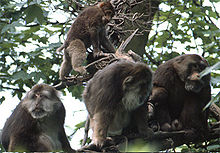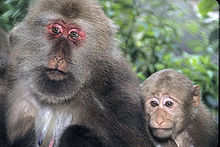Tibetan macaque
| Tibetan macaque | ||||||||||||
|---|---|---|---|---|---|---|---|---|---|---|---|---|

Tibetan macaque |
||||||||||||
| Systematics | ||||||||||||
|
||||||||||||
| Scientific name | ||||||||||||
| Macaca thibetana | ||||||||||||
| ( Milne Edwards , 1870) |
The Tibetan or Tibetan bear macaque ( Macaca thibetana ) is a primate species from the genus of macaques within the family of the vervet monkeys (Cercopithecidae).
description
Tibetan macaques have a thick, gray-brown fur. The face is hairless in an area around the nose and has light gray whiskers and goatee. The bare skin of the face is pale pink in males and bright pink in females. The length of the head body of these animals is around 51 to 71 centimeters, the tail is a stub that is around 4 to 14 centimeters long. At 14 to 17.5 kilograms, males are significantly heavier than females, who weigh 9 to 13 kilograms.
Distribution area and habitat
Tibetan macaques live in southern China , their range extends from eastern Tibet , Sichuan and Yunnan to Guangdong . Their habitat are forests, both subtropical moist forests and mountain forests up to 2000 meters above sea level.
Way of life
Tibetan macaques are diurnal and spend most of their lives on the ground. Like most macaques, they live in groups that consist of a few males, many females and their offspring. Both sexes develop a distinctive hierarchy within the group, which is reflected, among other things, in grooming and in the order of reproduction.
food
These animals are omnivores, but the main focus of their diet is on fruit. They also eat flowers, seeds, leaves as well as insects and small vertebrates.
Reproduction
After a gestation period of around 165 days, the female gives birth to a single young. The young animals have a black-gray fur that only takes on the color of the adults when they are around two years old. The young animals are weaned after 6 to 12 months and are sexually mature at 2.5 to 7 years of age. Life expectancy in the wild is estimated at around 20 years.
threat
The Tibetan macaques are protected in China, but their area of distribution has been fragmented by urban sprawl. There are particularly large deposits, for example, on Mount Emei Shan in Sichuan , and overall they are listed as low risk by the IUCN .
literature
- Thomas Geissmann : Comparative Primatology. Springer-Verlag, Berlin et al. 2003, ISBN 3-540-43645-6 .
- Don E. Wilson, DeeAnn M. Reeder (Eds.): Mammal Species of the World. A taxonomic and geographic Reference. Johns Hopkins University Press, Baltimore MD 2005, ISBN 0-8018-8221-4 .
Web links
- Photos and information on arkive.org
- Macaca thibetana in the endangered Red List species the IUCN 2006. Posted by: Eudey et al , 2000. Retrieved on 11 May, 2006.


